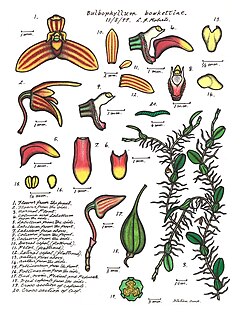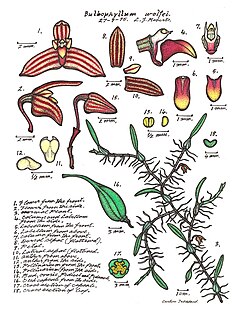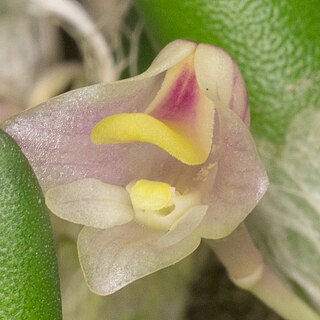
Bulbophyllum bowkettiae, commonly known as the striped snake orchid, is a species of epiphytic or lithophytic orchid with thin, creeping rhizomes and flattened pseudobulbs each with a single tough, dark green leaf and a single cream-coloured flower with red stripes. It grows on trees and rocks in rainforest in tropical North Queensland, Australia.

Dendrobium gracilicaule, commonly known as the blotched cane orchid or yellow cane orchid, is an epiphytic or lithophytic orchid in the family Orchidaceae. It has cylindrical pseudobulbs, between three and seven thin leaves and up to thirty often drooping, cream-coloured to yellow or greenish flowers, sometimes with reddish brown blotches on the back. There are two varieties, one occurring in Queensland and New South Wales and the other on some Pacific Islands, including Lord Howe Island.

Bulbophyllum baileyi, commonly known as the fruit fly orchid, is a species of epiphytic or lithophytic orchid that is native to Queensland and New Guinea. It has coarse, creeping rhizomes, curved, yellowish pseudobulbs with a single thick, fleshy leaf, and a single cream-coloured flower with yellow, red or purple spots. It grows on trees and rocks in open forest, often in exposed places.

Bulbophyllum elisae, commonly known as the pineapple orchid, is a species of epiphytic or lithophytic orchid that is endemic to eastern Australia. It has crowded, wrinkled, pale green or yellowish clump-forming pseudobulbs, stiff, pale green to yellowish leaves and between three and twelve pale green to dark green flowers with a dark red to purple labellum. It usually grows in the tops of rainforest trees, on cliff faces or boulders.

Bulbophyllum exiguum, commonly known as the tiny strand orchid, is a species of epiphytic or lithophytic orchid that is endemic to eastern Australia. It has small, roughly spherical pseudobulbs each with a single leaf and up to three small creamy white to yellow flowers emerging from the base of the pseudobulb. This orchid grows in rainforest and dry forest where it often covers the branches of trees or rocks on which it grows.
Bulbophyllum lamingtonense, commonly known as the cream rope orchid, is a species of epiphytic or lithophytic orchid with well-spaced pseudobulbs and brown bracts arranged along the stems. Each pseudobulb has a single, fleshy, channelled leaf and a single cream-coloured or white flower with yellow tips. It grows on trees and rocks near cliffs and the edge of rainforest near the eastern border between New South Wales and Queensland.
Bulbophyllum lilianae, commonly known as the warty strand orchid, is a species of epiphytic or lithophytic orchid that is endemic to tropical North Queensland. It has widely spaced, deeply grooved, dark green to yellowish pseudobulbs, thin but tough, dark green to yellowish leaves and up to three cream-coloured, pale green or reddish flowers with dark red stripes and a pink labellum. It grows on shrubs, trees and rocks, often in exposed situations.

Bulbophyllum longiflorum, commonly known as the pale umbrella orchid, is a species of epiphytic or lithophytic orchid. It has a creeping rhizome, widely spaced, dark green pseudobulbs with a single large, fleshy leaf, and flowers spreading in a semicircular umbel, resembling one-half of an umbrella. The flowers are canoe-shaped, greenish cream-coloured to yellowish with purple dots. It has a wide distribution and is found in parts of Africa, on islands in the Indian and Pacific Oceans, Southeast Asia, New Guinea and northern Australia.
Bulbophyllum minutissimum, commonly known as the red bead orchid or grain-of-wheat orchid, is a species of epiphytic or lithophytic orchid with small, flattened, reddish or green pseudobulbs, scale-like leaves and small whitish to reddish flowers with broad dar red stripes. It grows on trees and rocks, mostly in swamps and near streams in eastern Australia.

Bulbophyllum newportii, commonly known as the cupped strand orchid, is a species of epiphytic or lithophytic orchid that is endemic to tropical North Queensland. It has widely spaced, oval or cone-shaped, light green pseudobulbs, a single stiff, dark green egg-shaped leaf and up to eight bell-shaped white, cream-coloured or greenish flowers with a long, narrow yellow labellum. It grows on trees and rocks, usually at moderate to high elevations.

Bulbophyllum shepherdii, commonly known as the wheat-leaf rope orchid, is a species of epiphytic or lithophytic orchid that forms a dense mat of branching rhizomes pressed against the surface on which it grows. The pseudobulbs are well spaced along the rhizome, each with a single egg-shaped leaf and a single small, white or cream-coloured flower with yellow tips. It grows on trees and rocks in rainforest and is endemic to eastern Australia.

Bulbophyllum wadsworthii, commonly known as the yellow rope orchid, is a species of epiphytic or lithophytic orchid that forms clumps that hang off the surface on which the plant is growing. The pseudobulbs are small and partly hidden by brown, papery bracts. Each pseudobulb has a single fleshy, dark green leaf and a single star-shaped, cream-coloured or pale green flower with an orange labellum. It mainly grows on trees and rocks in rainforest and is endemic to Queensland.

Bulbophyllum wolfei, commonly known as the fleshy snake orchid, is a species of epiphytic or lithophytic orchid with thin, creeping rhizomes, and flattened pseudobulbs each with a single thick, fleshy, dark green leaf and a single cream-coloured flower with dark red stripes. It mostly grows on rainforest trees in tropical North Queensland.

Dendrobium smillieae, commonly known as the bottlebrush orchid, is an epiphytic or lithophytic orchid with large, spongy pseudobulbs, thin, bright green leaves which are shed after their first year and crowded flowers in a bottlebrush-like arrangement. The flowers are white, to cream-coloured or pink and the labellum has a shiny, dark green tip. This orchid species is found in some of the Torres Strait Islands, and through Cape York Peninsula to Townsville, Queensland. It is also found in New Guinea and eastern Indonesia.

Dendrobium moorei, commonly known as the drooping cane orchid, is a species of epiphytic or lithophytic orchid in the family Orchidaceae and is endemic to Lord Howe Island. It has cylindrical pseudobulbs, leathery, dark green leaves and between two and fifteen small, white drooping flowers that do not open widely.

Dendrobium agrostophyllum, the buttercup orchid, is an epiphytic or lithophytic orchid in the family Orchidaceae and has a creeping rhizome with well-spaced pseudobulbs. Each pseudobulb has up to twenty grass-like leaves, some of the leaves having flowering stems on the opposite side of the pseudobulb, each raceme with up to ten waxy, fragrant, bright yellow flowers. It grows in wet forest in coast areas of north Queensland, Australia.
Dendrobium fellowsii, commonly known as the native damsel orchid, is an epiphytic or lithophytic orchid in the family Orchidaceae and has upright pseudobulbs, up to five leaves and groups of up to five pale green or yellowish flowers with a deep purple labellum. It grows in tropical North Queensland.

Dendrobium lichenastrum, commonly known as the common button orchid, is a species of epiphytic or lithophytic orchid endemic to far north Queensland. It has a creeping, branching rhizome surrounded by papery bracts, small egg-shaped to round, fleshy, dark green leaves and a single white, cream-coloured or pink flower with red stripes and an orange labellum.

Dendrobium monophyllum, commonly known as the lily-of-the-valley orchid, is an epiphytic or lithophytic orchid in the family Orchidaceae. It has pale green to yellowish pseudobulbs with one or two leaves, and between five and twenty bell-shaped yellow flowers. It grows in rainforest in New South Wales and Queensland, Australia.

Dendrobium taylorii, commonly known as the smooth burr orchid, is an epiphytic or lithophytic orchid in the family Orchidaceae and is endemic to tropical North Queensland, Australia. It has a single leathery, dark green leaf on a cylindrical stem and one or two small white flowers. Unlike other burr orchids, this species is insect-pollinated. It grows in rainforest, mangroves and sheltered forests.















